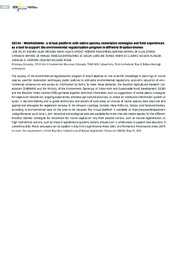Embrapa Clima Temperado
WebAmbiente- a virtual platform with native species, restoration strategies and field experiences as a tool to support the environmental regularization program in different Brazilian biomes.
Autoria: RIBEIRO, J. F.; NAKAI, A. M.; MILHOMENS, A. K. M.; SILVA, A. A. da; ARAUJO, S. C. B. de; SOUZA, R. B. de; TURAZI, C. M. V.; ALENCAR, M. de C. F.; SKORUPA, L. A.; ASSAD, E. D.
Resumo: The success of the environmental regularization program in Brazil depends on the scientific knowledge in plantings of native species used for restoration techniques, public policies to stimulate environmental regulations, economic valuation of environmental conservation and access to information by farms. To meet these demands, the Brazilian Agricultural Research Corporation (EMBRAPA) and the Ministry of the Environment (Secretary of Extrativism and Sustainable Rural Development (SEDR) and the Brazilian Forest Service (SFB)) gathered together technical information such as suggestions of native plants, strategies for vegetation restoration, ongoing experiences, and best agricultural practices, to create an interactive information system to assist in decision-making and to guide technicians and owners of rural areas on choices of native species, best practices and appropriate strategies for vegetation recovery in the Amazon, Caatinga, Cerrado, Mata Atlântica, Pampa, and Pantanal biomes, according to environmental data on the area to be restored. The virtual platform is available at https://www.embrapa.br/en/ codigo-florestal, as of June 5, 2017. Botanical and ecological data are available for more than 600 native species for the different Brazilian biomes. Strategies for restoration for native vegetation vary from passive actions, such as natural regeneration, to high intervention actions, such as those in agroforestry systems. Actions should start in small areas to support new decisions if something fails. These strategies can be applied in Brazil for Legal Reserve Areas (ARL) and Permanent Preservation Areas (APP) to meet the requirements of the Brazilian Federal Law of Native Vegetation Protection (12651), May 25, 2012.
Ano de publicação: 2017
Tipo de publicação: Resumo em anais e proceedings
Unidade: Embrapa Meio Ambiente
Palavras-chave: Espécies nativas

